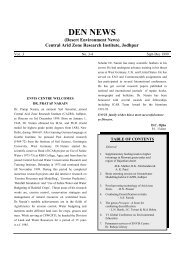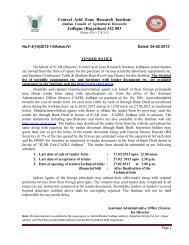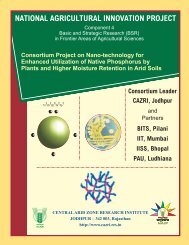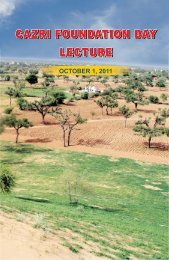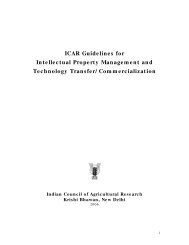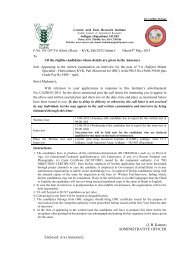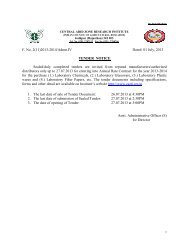- Page 1 and 2: NATURAL RESOURCES AND DESERTIFICATI
- Page 3 and 4: The aridity index line has shifted
- Page 5 and 6: oth the flood year and drought year
- Page 7 and 8: 20 Paramanik, S.K. and Jagannathan,
- Page 9 and 10: Based on the weekly water balance c
- Page 11 and 12: On prediction of droughts in the In
- Page 13 and 14: millet production has established a
- Page 15 and 16: months of June, July, August and Se
- Page 17 and 18: Though the seasonal rainfall exceed
- Page 19 and 20: crop yields, agrodemographic and ag
- Page 21 and 22: The rainfall distribution pattern,
- Page 23 and 24: 1976 at four heights above ground (
- Page 25 and 26: occurrence in recent landforms (lev
- Page 27 and 28: evidence of collateral transport su
- Page 29 and 30: Quick method of aerial photogrammet
- Page 31: maintenance, drainage density, rugg
- Page 35 and 36: 105 Kar, A. (1994)Lineament control
- Page 37 and 38: 112 Pandey, S. (1965)Geomorphology
- Page 39 and 40: The map indicates the areas where s
- Page 41 and 42: In addition to aridity, scarcity of
- Page 43 and 44: Geomorphological analysis of landfo
- Page 45 and 46: The origin, morphology, source and
- Page 47 and 48: An attempt has been made to integra
- Page 49 and 50: landforms, soil texture and soil de
- Page 51 and 52: Soil Resources158 Abichandani, C.T.
- Page 53 and 54: Genesis and characteristics of dune
- Page 55 and 56: g -1 ) was found to be a function o
- Page 57 and 58: 178 Choudhari, J.S. and Dhir, R.P.
- Page 59 and 60: and CEC determinations. Five clays
- Page 61 and 62: A wide spectrum of soils spread ove
- Page 63 and 64: dune and interdunal soils. Correlat
- Page 65 and 66: In forty two surface soil samples (
- Page 67 and 68: coagulation threshold values. Thus,
- Page 69 and 70: analysis revealed (i) positive infl
- Page 71 and 72: Distribution of different forms of
- Page 73 and 74: Chemical and potentiometric titrati
- Page 75 and 76: constants varied from 1.18 to 5.26
- Page 77 and 78: capacity of soils indicated their i
- Page 79 and 80: Potentiality of LANDSAT, SPOT and I
- Page 81 and 82: tributaries revealed that the avail
- Page 83 and 84:
clay. No significant relationship w
- Page 85 and 86:
equations both linear and quadratic
- Page 87 and 88:
the conservation of its salinity si
- Page 89 and 90:
Three profiles, representing two so
- Page 91 and 92:
adsorption gave good agreement betw
- Page 93 and 94:
A concealed ridge has also been loc
- Page 95 and 96:
and buried pediments. The dominant
- Page 97 and 98:
Phalodi has the minimum. Chlorides
- Page 99 and 100:
oth in respect of surface and groun
- Page 101 and 102:
305 Gupta, B.S. and Kolarkar, A.S.
- Page 103 and 104:
product for fluoride. High fluoride
- Page 105 and 106:
evaporation indirectly by conveying
- Page 107 and 108:
Quality of underground water and it
- Page 109 and 110:
Quality of ground water for irrigat
- Page 111 and 112:
A conceptual sediment transport mod
- Page 113 and 114:
346 Sharma, K.D., Singh, H.P., Pare
- Page 115 and 116:
Impact of present and palaeo draina
- Page 117 and 118:
Application of remote sensing techn
- Page 119 and 120:
Geo-electrical investigation on sub
- Page 121 and 122:
A considerable area of western Raja
- Page 123 and 124:
uoyancy. The parachute-like pappus
- Page 125 and 126:
Chemical analyses show that Rajasth
- Page 127 and 128:
392 Kanodia, K.C. and Gupta, R.K. (
- Page 129 and 130:
399 Puri, G.S. (1954)Plant ecologic
- Page 131 and 132:
Studies on the vegetation and flora
- Page 133 and 134:
forests of the district are categor
- Page 135 and 136:
Ecological studies on Hippophae rha
- Page 137 and 138:
of sites in different groupings hel
- Page 139 and 140:
observed. The estimate of total dry
- Page 141 and 142:
out for 1963-64 and 1983-84 and cha
- Page 143 and 144:
India's total arid zone and about 2
- Page 145 and 146:
The system of agriculture followed
- Page 147 and 148:
There are five landform units such
- Page 149 and 150:
shifting sand dunes, severe wind er
- Page 151 and 152:
have been demarcated and mapped on
- Page 153 and 154:
Chitradurga district has been highl
- Page 155 and 156:
Impact of geomorphology on the land
- Page 157 and 158:
population and man's increased comp
- Page 159 and 160:
The desertification process - an ov
- Page 161 and 162:
Local (micro level) soil degradatio
- Page 163 and 164:
Maps of soil degradation and soil d
- Page 165:
changes indicate that the desertic
- Page 168 and 169:
average of 32% over the same test e
- Page 170 and 171:
Hybrids and the cytoplasmic male st
- Page 172 and 173:
515 Manga, V.K., Gupta, B.S. and Sa
- Page 174 and 175:
522 Sharma, A.K. and Choudhary, B.R
- Page 176 and 177:
lines were taller, while no particu
- Page 178 and 179:
In a 6 x 6 diallel cross of cluster
- Page 180 and 181:
espectively, and were low yielders.
- Page 182 and 183:
component was also significant. The
- Page 184 and 185:
554 Henry, A. and Krishna, G.V.S.R.
- Page 186 and 187:
Inter-cluster distance was maximum
- Page 188 and 189:
567 Jhorar, B.S., Solanki, K.R. and
- Page 190 and 191:
various phenotypic characters. The
- Page 192 and 193:
Genotype x environment interaction
- Page 194 and 195:
Two new varieties of Ricinus commun
- Page 196 and 197:
particularly from flowering to sili
- Page 198 and 199:
Phenotypic stability of certain gro
- Page 200 and 201:
602 Godawat, S.L., Sharma, A.K. and
- Page 202 and 203:
609 Bishnoi, O.P., Umamaheshwara Ra
- Page 204 and 205:
Inter-cropping of grasses and legum
- Page 206 and 207:
Wheat had the highest water-use eff
- Page 208 and 209:
sprinkling water treatments were fo
- Page 210 and 211:
The paper summarises the results of
- Page 212 and 213:
Leaf area determination in pearl mi
- Page 214 and 215:
Safflower for better utilisation of
- Page 216 and 217:
also improved by phosphatic fertili
- Page 218 and 219:
16.9% inspite of 1.5% increased cov
- Page 220 and 221:
Nitrogen application alone at 10 an
- Page 222 and 223:
physiological maturity stage. This
- Page 224 and 225:
indicated that cotton crop is more
- Page 226 and 227:
679 Saxena, A., Singh, D.V. and Jos
- Page 228 and 229:
Moisture fluctuations, moisture use
- Page 230 and 231:
cowpea and sunflower + green gram i
- Page 232 and 233:
In a 2 year study on arid land, dou
- Page 234 and 235:
Agronomic efficiency of all N-carri
- Page 236 and 237:
in the inter-spaces, the additional
- Page 238 and 239:
thermal time under arid conditions.
- Page 240 and 241:
Yield-water-nitrogen response analy
- Page 242 and 243:
Studies of tillage-fertility on pea
- Page 244 and 245:
The erect variety AK 12-24 showed m
- Page 246 and 247:
nutrient-supply systems through tre
- Page 248 and 249:
percentage relative turgidity at al
- Page 250 and 251:
748 Yadav, R.C. and Gupta, J.P. (19
- Page 252 and 253:
with higher levels of salt stress.
- Page 254 and 255:
Effects of Na 2 CO 3 and NaHCO 3 we
- Page 256 and 257:
Influence of salts on growth, yield
- Page 258 and 259:
metabolism enzymes as well as on co
- Page 260 and 261:
Since drought and salt stresses app
- Page 262 and 263:
782 Kathju, S., Kackar, N.L. and La
- Page 264 and 265:
788 Lahiri, A.N. (1970)Studies on p
- Page 266 and 267:
Studies on plant-water relationship
- Page 268 and 269:
progressive oxidation of ammonia. T
- Page 270 and 271:
drought, the grain yield was also d
- Page 272 and 273:
complex than producing drought. Rec
- Page 274 and 275:
814 Nathawat, K.S., Joshi, P., Bagr
- Page 276 and 277:
germinated satisfactorily up to the
- Page 278 and 279:
Relative salt tolerance of differen
- Page 280 and 281:
832 Venkateswarlu, B. , Rao, A.V. a
- Page 282 and 283:
838 Vyas, S.P., Kathju, S., Garg, B
- Page 284 and 285:
The available literature on status
- Page 286 and 287:
water. The soils under rainfed farm
- Page 288 and 289:
N. Amongst organic-N hydrolysable f
- Page 290 and 291:
48% when elemental sulphur was mixe
- Page 292 and 293:
867 Daulay, H.S. and Singh, K.C. (1
- Page 294 and 295:
Mean yield of sorghum shoot studied
- Page 296 and 297:
Considerably large quantities of th
- Page 298 and 299:
for Azadirachta indica, Acacia tort
- Page 300 and 301:
893 Polara, K.B., Patel, C.L. and P
- Page 302 and 303:
900 Praveen-Kumar and Burman, U. (1
- Page 304 and 305:
The present study was carried out t
- Page 306 and 307:
considerable variation in numbers f
- Page 308 and 309:
which was considerably enhanced fol
- Page 310 and 311:
FC) showed higher N losses as compa
- Page 312 and 313:
In the present study, temperature a
- Page 314 and 315:
arietinum Linn.). In wheat, signifi
- Page 316 and 317:
The efficiency of different phospha
- Page 318 and 319:
Attempts were made to grow the micr
- Page 320 and 321:
946 Venkobarao, K., Nair, P.K., Pra
- Page 322 and 323:
techniques could, therefore, be use
- Page 324 and 325:
porosity and dry aggregates > 0.25
- Page 326 and 327:
characteristics, available water ca
- Page 328 and 329:
Irrigation Water970 Bhaskar, K.S. (
- Page 330 and 331:
Susceptibility to foliar injury dep
- Page 332 and 333:
energies (- G) being 6.11 K Cal deg
- Page 334 and 335:
988 Gupta, I.C. and Abichandani, C.
- Page 336 and 337:
Algalization of sorghum and wheat f
- Page 338 and 339:
efficiency (6.51 kg ha -1 mm) than
- Page 340 and 341:
production, suffers heavy yield los
- Page 342 and 343:
wheat, lower or higher than usual d
- Page 344 and 345:
and reproductive stages as against
- Page 346 and 347:
1023 Vijay Kumar, and Raheja, P.C.
- Page 348 and 349:
The predominant weed species associ
- Page 350 and 351:
1036 Sen, D.N., Bhandari, D.C. and
- Page 352 and 353:
Optimum growth of the fungus on Kir
- Page 354 and 355:
after sowing gave the best results
- Page 356 and 357:
1058 Kumar, A. and Arya, H.C. (1978
- Page 358 and 359:
In October 1990 air-borne teliospor
- Page 360 and 361:
phaseolina. In path coefficient ana
- Page 362 and 363:
Development of bacterial blight (Xa
- Page 364 and 365:
pearl millet and blue panic-grass (
- Page 366 and 367:
with dark brown to black patches an
- Page 368 and 369:
Studies on the biology and control
- Page 370 and 371:
Studies on the efficacy of carbofur
- Page 372 and 373:
Sphingonotus rubescens showed egg d
- Page 374 and 375:
1118 Parihar, D.R. (1993)Field obse
- Page 376 and 377:
while it was the least in the salin
- Page 378 and 379:
The sexes do not differ in respect
- Page 380 and 381:
The aphid infestation can cause sub
- Page 382 and 383:
dimethoate were found to be very ef
- Page 384 and 385:
the amount of food consumed. There
- Page 386 and 387:
The pest complex of pulses are capa
- Page 388 and 389:
The mite population on all the vari
- Page 390 and 391:
1172 Verma, S.K. (1987)Relative hos
- Page 392 and 393:
probably to the toxic effects of th
- Page 394 and 395:
The burrowing pattern of Rattus gle
- Page 396 and 397:
indica is nocturnal. The average ti
- Page 398 and 399:
have been recorded during summer. W
- Page 400 and 401:
of more aggressive, nocturnal, symp
- Page 402 and 403:
this sand coloured rat. Additives l
- Page 404 and 405:
A positive and significant correlat
- Page 406 and 407:
1226 Jain, A.P., Mathur, M. and Tri
- Page 408 and 409:
maximum in bottlegourd followed by
- Page 410 and 411:
the soil and certain vegetation typ
- Page 412 and 413:
addition of either of the two veget
- Page 414 and 415:
20.2%, grass seeds 6.7% and insects
- Page 416 and 417:
The relative numbers of R. meltada
- Page 418 and 419:
marking behaviour was exhibited onl
- Page 420 and 421:
indica and Mus booduga. The percent
- Page 423 and 424:
FRUITS AND VEGETABLESBer1275 Ahlawa
- Page 425 and 426:
the fruit. TSS, total sugars and Vi
- Page 427 and 428:
The plants were pruned on three dat
- Page 429 and 430:
Tree height, spread and number of p
- Page 431 and 432:
1306 Swaminathan, R. and Verma, S.K
- Page 433 and 434:
positively correlated with the shru
- Page 435 and 436:
1321 Bankar, G.J., Dass, H.C., Pras
- Page 437 and 438:
Shoot length and number of leaves p
- Page 439 and 440:
germinated into complete plantlets
- Page 441 and 442:
Growth, yield and water economy in
- Page 443 and 444:
cucurbitaceous vegetables. Hence, t
- Page 445 and 446:
Observations on shoot growth indica
- Page 447 and 448:
Influence of moisture stress on the
- Page 449 and 450:
Weight, size, specific gravity and
- Page 451 and 452:
Herbage production and nutrient com
- Page 453 and 454:
consecutive years from 1978 to 1980
- Page 455 and 456:
under arid and semi-arid conditions
- Page 457 and 458:
forage production, 1 cutting is des
- Page 459 and 460:
1401 Dabadghao, P.M., Chakravarty,
- Page 461 and 462:
various edaphic conditions. Plant h
- Page 463 and 464:
and cellulose had positive and sign
- Page 465 and 466:
var. criniformis, an annual grass i
- Page 467 and 468:
herbarium material coupled with cri
- Page 469 and 470:
is 0.48%. When expressed as fractio
- Page 471 and 472:
per day, respectively. The average
- Page 473 and 474:
system of C. setigerus and of serin
- Page 475 and 476:
1449 Puri, G.S. and Jain, S.K. (196
- Page 477 and 478:
Several tropical grasses native to
- Page 479 and 480:
Stability of Dichanthium annulatum
- Page 481 and 482:
esponse of phosphorus or the seed y
- Page 483 and 484:
Maximum air temperature and wind sp
- Page 485 and 486:
1 for March with 0.7 pan coefficien
- Page 487 and 488:
studied, Digestibility of all the n
- Page 489 and 490:
Progress by selection could be achi
- Page 491 and 492:
productive animals on the ranges du
- Page 493 and 494:
nutritive value of pasture forage a
- Page 495 and 496:
fertility status support these rang
- Page 497 and 498:
generate Rs. 0.11. The positive net
- Page 499 and 500:
discer operations without any ferti
- Page 501 and 502:
Research priorities for improvement
- Page 503 and 504:
A review of the fodder and grasslan
- Page 505 and 506:
Impact of overgrazing on the grassl
- Page 507 and 508:
Eight cultivars of Stylosanthes spe
- Page 509 and 510:
to very low carrying capacity these
- Page 511 and 512:
Variation in seed germination and s
- Page 513 and 514:
electrical current and mechanical s
- Page 515 and 516:
Effect of high temperatures on mois
- Page 517 and 518:
Salvadora oleoides, S. persica and
- Page 519 and 520:
Rain-water management for tree plan
- Page 521 and 522:
and pH of 10.3 (in sandy soil) and
- Page 523 and 524:
1588 Gupta, I.C., Yadav, N.D., Sing
- Page 525 and 526:
Performance of tree species in salt
- Page 527 and 528:
One hundred twenty three seed sampl
- Page 529 and 530:
Variation in seed production and it
- Page 531 and 532:
Nodulation in seedlings of Prosopis
- Page 533 and 534:
occurring in the grazing land has b
- Page 535 and 536:
Sub-surface watering of tree seedli
- Page 537 and 538:
evealed that germination percentage
- Page 539 and 540:
antenna and mouth parts. Though no
- Page 541 and 542:
height and Diameter at Breast Heigh
- Page 543 and 544:
Phenolics in leaf extracts of six P
- Page 545 and 546:
habits and percentage presence per
- Page 547 and 548:
simultaneously with reseeding or af
- Page 549 and 550:
ohida (T. undulata). No genotype sh
- Page 551 and 552:
1681 Sharma, N.K., Harsh, L.N., Tew
- Page 553 and 554:
Effect of seed treatment on germina
- Page 555 and 556:
Annual changes in components of var
- Page 557 and 558:
1701 Tewari, J.C., Sharma, N.K., Ha
- Page 559 and 560:
younger and thinner branches. Heavy
- Page 561 and 562:
y 10 and 7°C at 5 cm depth in dry
- Page 563 and 564:
The seeds of H. recurvum were subje
- Page 565 and 566:
It is to emphasise here that commer
- Page 567 and 568:
important forage shrub as it remain
- Page 569 and 570:
triacontanol which is 2 to 6 times
- Page 571 and 572:
thickness; the outer layer is littl
- Page 573 and 574:
Relative toxicity of four insectici
- Page 575 and 576:
Visual quantification studies on Cy
- Page 577 and 578:
the roots of jojoba. While the N 2
- Page 579 and 580:
Nitrogen fixing capacity of L. dive
- Page 581 and 582:
teak. Leucaena produced the minimum
- Page 583 and 584:
Compatibility studies on Acacia tor
- Page 585 and 586:
Ley-farmingsustainable manner. Mana
- Page 587 and 588:
WATERSHED MANAGEMENT AND SOIL CONSE
- Page 589 and 590:
leaving the surface moist. If stand
- Page 591 and 592:
Sedimentation and its control in na
- Page 593 and 594:
Soil Conservation1820 Aggarwal, R.K
- Page 595 and 596:
suitable plant species for sand fix
- Page 597 and 598:
view of the different topo-climates
- Page 599 and 600:
Reviews the causes of erosion; draw
- Page 601 and 602:
LIVESTOCK PRODUCTION AND MANAGEMENT
- Page 603 and 604:
eported in this communication provi
- Page 605 and 606:
producing animals, biotic interfere
- Page 607 and 608:
This study was conducted to evaluat
- Page 609 and 610:
1869 Kandasamy, N. and Sahni, K.L.
- Page 611 and 612:
Data were collected on the number o
- Page 613 and 614:
Studies on adaptability of sheep to
- Page 615 and 616:
It increased with the advancement o
- Page 617 and 618:
1894 Mali, P.C., Patnayak, B.C. and
- Page 619 and 620:
1898 Mathur, O.P. (1990)Evaluation
- Page 621 and 622:
was 144, 161 and 196 mg/100ml, resp
- Page 623 and 624:
A note of physical and biochemical
- Page 625 and 626:
A note on crossbreeding for fat-lam
- Page 627 and 628:
noted in both the breeds while an i
- Page 629 and 630:
Differences in blood and serum char
- Page 631 and 632:
The overall coefficient of correlat
- Page 633 and 634:
Effect of feed supplementation in g
- Page 635 and 636:
CamelIneffective places, life cycle
- Page 637 and 638:
Competition for resource utilisatio
- Page 639 and 640:
1959 Pancholy, R. and Mali, P.C. (1
- Page 641 and 642:
Uniform addition of LAB culture at
- Page 643 and 644:
WASTELAND MANAGEMENTSaline and Alka
- Page 645 and 646:
compared to others. Continuous irri
- Page 647 and 648:
accordingly to the nature and inten
- Page 649 and 650:
leaching, have been suggested as so
- Page 651 and 652:
An alkali soil, treated with gypsum
- Page 653 and 654:
Generally this acid occurs in trace
- Page 655 and 656:
and SS group on middle and upper sl
- Page 657 and 658:
Thirty-one plant species, including
- Page 659 and 660:
The storage of solar energy in a sy
- Page 661 and 662:
temperature and geometry and materi
- Page 663 and 664:
2035 Malhotra, K.S. and Nahar, N.M.
- Page 665 and 666:
dehydrating fruit and vegetables an
- Page 667 and 668:
20° C. The same device can also be
- Page 669 and 670:
A large size non-tracking solar coo
- Page 671 and 672:
improved natural circulation type s
- Page 673 and 674:
flat plate collector-storage solar
- Page 675 and 676:
This paper reports the design, deve
- Page 677 and 678:
solar dryer, the drying time for ch
- Page 679 and 680:
shifting soils affecting cultivated
- Page 681 and 682:
Discusses the results of the survey
- Page 683 and 684:
In this paper it is proposed to eva
- Page 685 and 686:
agricultural produce. Most of the u
- Page 687 and 688:
agricultural workers, as the crucia
- Page 689 and 690:
predisposed to high growth rate. Th
- Page 691 and 692:
units of human population is compar
- Page 693 and 694:
practices in different land form un
- Page 695 and 696:
The rate of diffusion in general wa
- Page 697 and 698:
Nomadism and migration are conspicu
- Page 699 and 700:
decreasing sesame production is tra
- Page 701 and 702:
analysed. The analysis revealed tha
- Page 703 and 704:
Date palm plantations offer an attr
- Page 705 and 706:
Area under tenancy and rural litera
- Page 707 and 708:
area. The interesting observation w
- Page 709 and 710:
2176 Gupta, B.S., Mathur, B.K. and
- Page 711 and 712:
less cost-effective. To generate vi
- Page 713 and 714:
Agrarian development is a precondit
- Page 715 and 716:
Himachal Pradesh. It suggests some
- Page 717 and 718:
2199 Mruthyunjaya and Sirohi, A.S.
- Page 719 and 720:
contributing to an intensification
- Page 721 and 722:
2211 Sehara, D.B.S. and Purohit, M.
- Page 723 and 724:
2217 Singh, M. and Singh, R.P. (198
- Page 725 and 726:
The measurement of asset productivi
- Page 727 and 728:
temperature and mean relative humid
- Page 729 and 730:
transfer of technology from the res
- Page 731 and 732:
2243 Saha, D.K., Malhotra, S.P. and
- Page 733 and 734:
plant, Number of grains per plant w
- Page 735 and 736:
conditions, inadequate nutritional
- Page 737 and 738:
The blackbuck in relation to its de
- Page 739 and 740:
listed. Simplified food chains are
- Page 741 and 742:
MISCELLANEOUS2270 Aminullah. (1970)
- Page 743 and 744:
2277 Venkataraman, P.K. (1962)Natur
- Page 745 and 746:
Proceedings of the symposium on the
- Page 747 and 748:
2288 Gupta, I.C. (1990)Use of salin
- Page 749 and 750:
Proceedings of the symposium on pro
- Page 751 and 752:
2300 Kolarkar, A.S., Joshi, D.C. an
- Page 753 and 754:
2305 Kumar, D. and Rai, M. (1992)Ad
- Page 755 and 756:
A. Issar; Environmental Conservatio
- Page 757 and 758:
Agricultural atlas of Rajasthan. Ne
- Page 759 and 760:
unit has been suggested along with
- Page 761 and 762:
and plant protection measures. The
- Page 763 and 764:
in improvement of the quality of li
- Page 765 and 766:
Agro-forestry : a judicious use of
- Page 767 and 768:
and P.K. Ghosh; Trace element conce
- Page 769 and 770:
have been summarised in this public
- Page 771 and 772:
2343 Prakash, I. (1977)The amazing
- Page 773 and 774:
the wool produced from the whole co
- Page 775 and 776:
species, Horti and silivi pastoral
- Page 777 and 778:
2355 Vinod Shankar. (1983)Depleted



